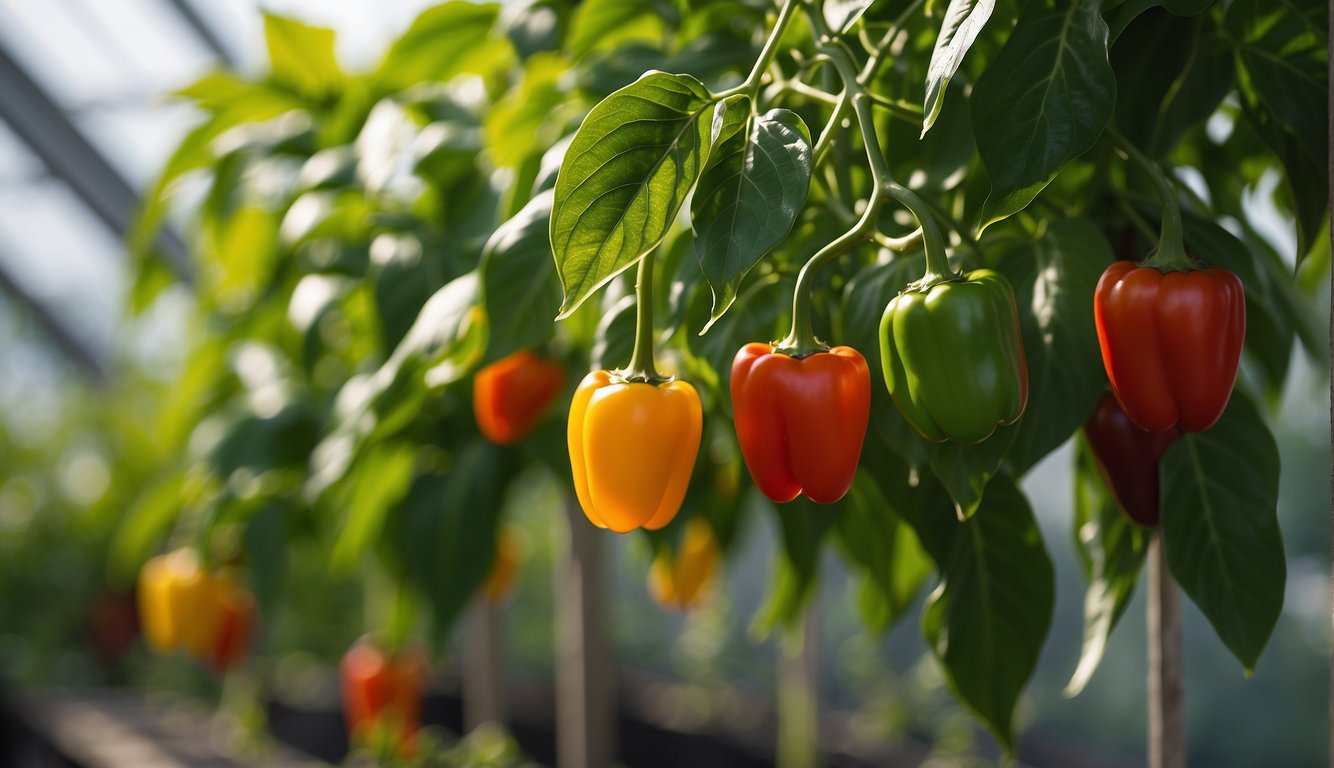TheHerbProf.com is a treasure trove of knowledge for those interested in natural healing and herbal remedies. The website is run by Paul Johnston MD. A naturopathic who has not only received extensive education in the field but also has personal experience in self-healing.
Growing peppers in a greenhouse is a great way to extend the growing season and produce a bountiful harvest. Greenhouse gardening offers many advantages, especially when growing peppers. This controlled environment can lead to more beneficial plants and a more productive harvest. Peppers, with their varied types and flavors, are particularly well-suited for greenhouse cultivation.
One of the biggest benefits of growing peppers in a greenhouse is the ability to control the environment. Unlike outdoor gardening, you can regulate the temperature, humidity, and light levels to create the perfect growing conditions for your peppers. This means you can grow peppers year-round, regardless of the weather outside.
Another advantage of growing peppers in a greenhouse is that you can protect your plants from pests and diseases. Greenhouses create a barrier between your plants and the outside world, which can help prevent infestations and infections. Additionally, you can use natural pest control methods like ladybugs and praying mantises to keep pests at bay. With the right care and attention, you can grow healthy, robust peppers in your greenhouse.
Choosing the Right Pepper Varieties – Growing Peppers in a Greenhouse
When it comes to growing peppers in a greenhouse, choosing the right pepper varieties is crucial to ensure a successful harvest. In this section, I will discuss the differences between sweet and spicy peppers and popular types such as bell peppers.
Sweet vs Spicy Peppers – Growing Peppers in a Greenhouse
Pepper varieties can be broadly classified into two categories: sweet and spicy. Sweet peppers, also known as bell peppers, have a mild, sweet flavor and are often used in salads, stir-fries, and stuffed dishes. On the other hand, spicy peppers, such as the ghost pepper, have a hot and pungent flavor and are used in sauces, marinades, and spice blends.
When choosing between sweet and spicy peppers, it is important to consider your personal taste preferences and the intended use of the peppers. Sweet bell peppers are a popular choice for greenhouse growers due to their versatility and high demand in the market. However, if you are looking to add some heat to your dishes, spicy peppers may be a better option.
Bell Peppers and Other Popular Types
Bell peppers are one of the most popular types of sweet peppers and come in a variety of colors, including green, red, yellow, and orange. They are easy to grow and have a high yield, making them a favorite among greenhouse growers. Other popular types of sweet peppers include banana peppers, cherry peppers, and pimiento peppers.
Spicy pepper varieties are more diverse and include the ghost pepper, habanero pepper, jalapeño pepper, and cayenne pepper. Each variety has its own unique flavor and heat level, so it is important to choose the right one based on your preferences.
In addition to flavor, it is also important to consider the growing conditions required for each pepper variety. Some varieties may require specific temperatures, humidity levels, and soil conditions, so it is important to do your research before selecting a pepper variety to grow in your greenhouse.
Overall, choosing the right pepper varieties is essential for a successful greenhouse harvest. By considering factors such as flavor, heat level, and growing conditions, you can ensure that your pepper plants thrive and produce high-quality fruits.
Starting from Seeds – Growing Peppers in a Greenhouse
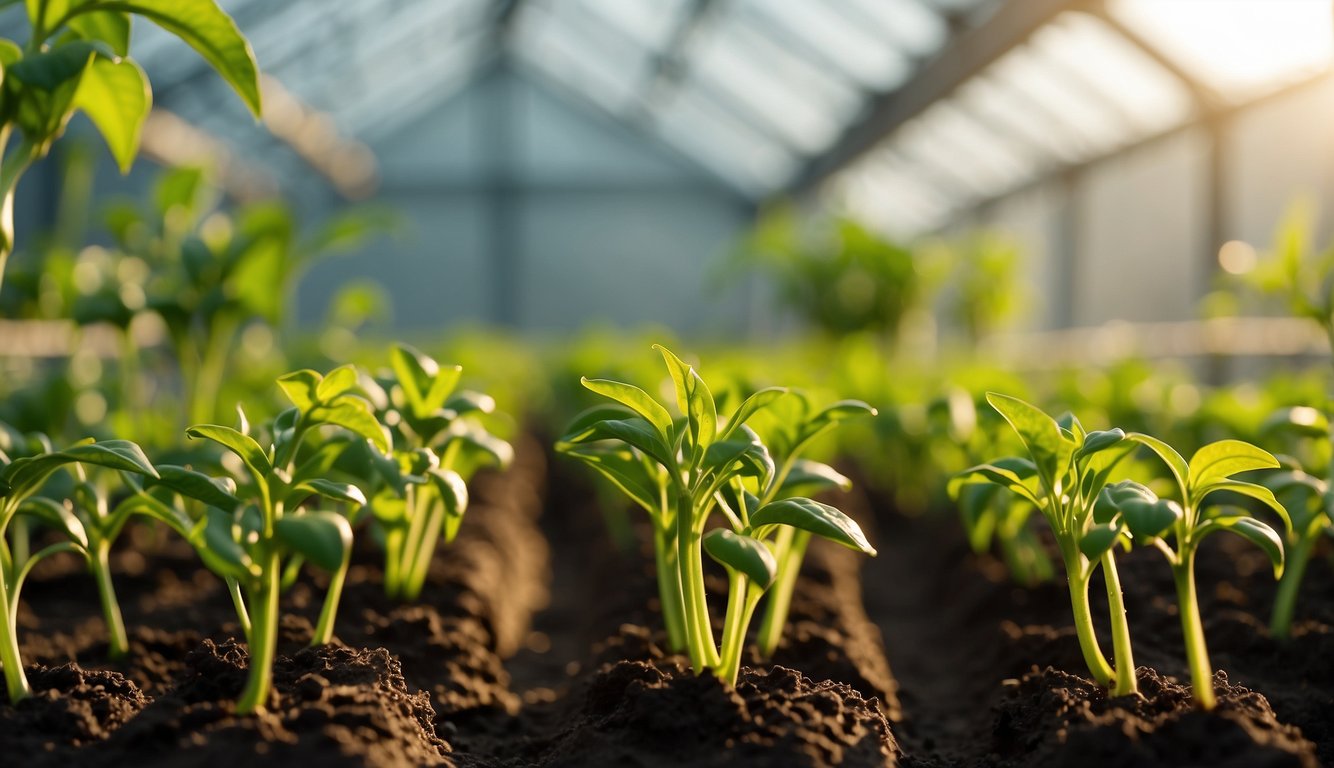
Growing peppers from seeds is a satisfying and cost-effective way to start your greenhouse pepper garden. In this section, I will discuss the essential steps for starting peppers from seeds.
Sowing Pepper Seeds
The first step in growing peppers from seed is to sow the seeds in a suitable medium. You can use either soil or a soilless mix to start your seeds. Ensure that the medium is moist but not waterlogged. Sow the seeds 1/4 to 1/2 inch deep and cover them lightly with the medium.
Pepper seeds require warm soil temperatures for germination. Maintain a constant soil temperature of 80-90°F (27-32°C) for best results. You can use a seedling heat mat to maintain the soil temperature.
Germinating Pepper Seeds
Pepper seeds can take 7-10 days to germinate. Once they have germinated, the seedlings will develop their first set of true leaves. At this point, you can transplant them into individual containers or cell trays.
Ensure that the seedlings receive adequate light, water, and nutrients. You can use a balanced fertilizer to feed them.
Starting peppers from seeds is an easy and rewarding way to begin your greenhouse pepper garden. By following the steps outlined in this section, you can germinate healthy pepper seedlings and grow them into productive plants.
Greenhouse Environment Control – Growing Peppers in a Greenhouse
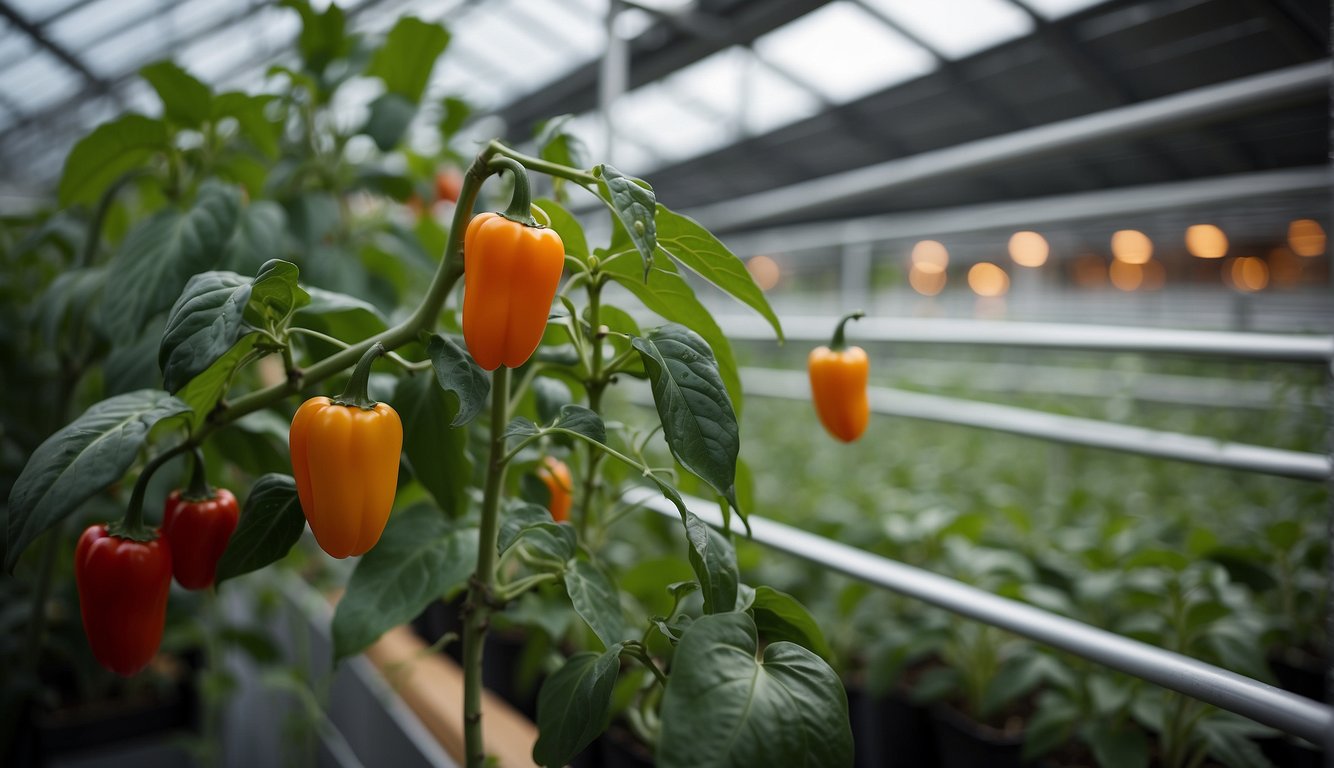
As a greenhouse pepper grower, I know how important it is to maintain a controlled environment for optimal plant growth. Two of the most critical factors to control are temperature and humidity.
Temperature and Humidity – Growing Peppers in a Greenhouse
Peppers thrive in warm temperatures, ideally between 70-80°F. However, it’s essential to monitor the temperature regularly to avoid overheating, which can damage the plants. To maintain a consistent temperature, I recommend using a thermostat to control the heating system.
Humidity is also crucial for pepper growth. High humidity levels can cause disease, while low humidity can lead to wilting and stunted growth. I suggest keeping the humidity level between 60-70% during the day and 80-90% at night. To achieve this, I use a humidifier and a dehumidifier in my greenhouse.
Light and Air Circulation
Peppers require full sun exposure to grow, so it’s essential to maximize the amount of light they receive. I recommend placing the greenhouse in a location with maximum sunlight exposure and using supplemental lighting during the winter months.
Air circulation is crucial for preventing disease and promoting healthy plant growth. I use fans to maintain air circulation in my greenhouse. I recommend placing fans strategically to ensure that air circulates evenly throughout the greenhouse.
In summary, controlling the environment is critical for growing healthy pepper plants in a greenhouse. By maintaining optimal temperature and humidity levels and maximizing light and air circulation, you can ensure a bountiful harvest.
Soil and Water Management – Growing Peppers in a Greenhouse
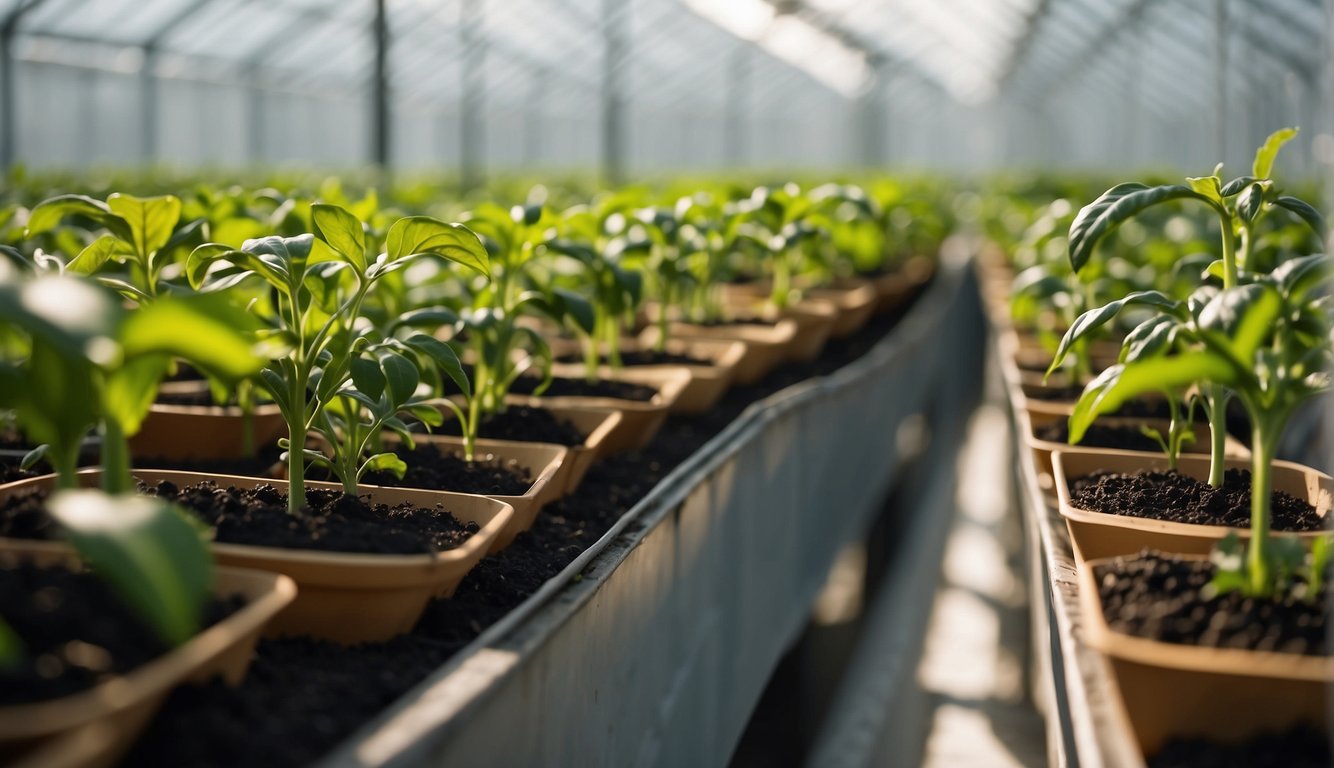
As a greenhouse pepper grower, it is crucial to pay attention to soil and water management. Proper soil preparation and watering techniques will ensure that your peppers are healthy and productive. In this section, I will discuss soil preparation and pH levels as well as watering techniques and moisture levels.
Soil Preparation and pH Levels – Growing Peppers in a Greenhouse
Before planting your peppers, it is essential to prepare the soil. A rich soil with plenty of organic matter and nutrients will provide your peppers with the necessary nutrients for growth. Adding compost to the soil is an excellent way to improve soil structure and fertility.
It is also crucial to test the soil pH levels. Peppers prefer a slightly acidic soil with a pH range between 6.0 and 6.8. If the soil pH is too high or too low, it can affect the plant’s ability to absorb nutrients, resulting in stunted growth and poor yields. If the soil pH is too low, you can add lime to raise it. If the soil pH is too high, you can add sulfur to lower it.
Watering Techniques and Moisture Levels
Proper watering techniques and moisture levels are critical for greenhouse pepper growing success. Overwatering can lead to root rot, while underwatering can cause stress and poor growth. It is essential to maintain consistent moisture levels in the soil.
One way to ensure consistent moisture levels is to use a drip irrigation system. Drip irrigation delivers water directly to the roots, reducing water waste and minimizing the risk of overwatering. It is also essential to monitor the moisture levels in the soil regularly. You can use a moisture meter to determine when it is time to water your peppers.
Proper soil and water management are critical for greenhouse pepper growing success. By preparing your soil correctly and using proper watering techniques, you can ensure that your peppers are healthy and productive.
Nutrition and Feeding – Growing Peppers in a Greenhouse
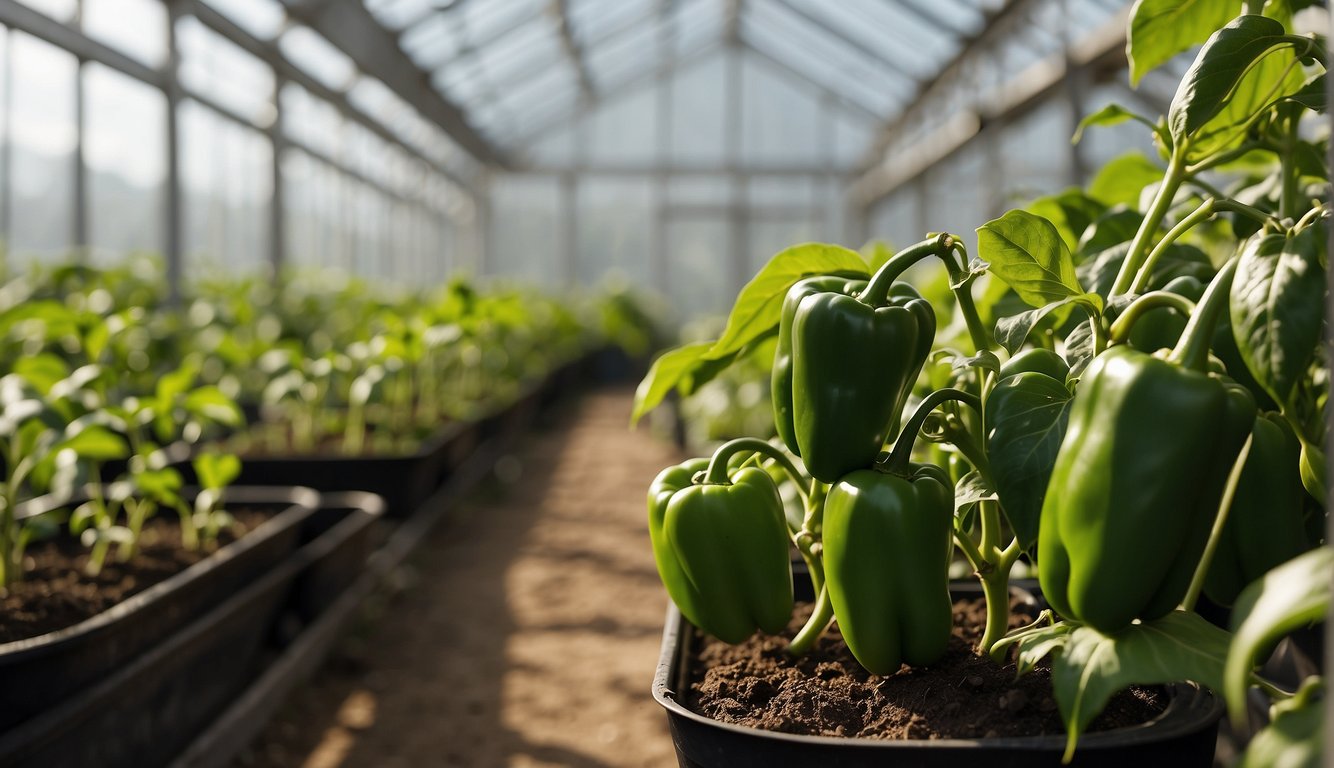
As a greenhouse gardener, I know that proper nutrition and feeding are essential for growing healthy pepper plants. In this section, I will discuss the essential nutrients for pepper growth and a fertilizing schedule that will help ensure maximum yield.
Essential Nutrients for Pepper Growth – Growing Peppers in a Greenhouse
Peppers require a variety of nutrients to grow properly, including iron, calcium, potassium, phosphorus, and nitrogen. Iron is essential for the formation of chlorophyll, which is necessary for photosynthesis. Calcium is important for cell wall structure and helps prevent blossom end rot. Potassium is essential for plant growth and helps regulate water balance. Phosphorus is necessary for root development and flower and fruit formation. Nitrogen is essential for overall plant growth and is a component of chlorophyll.
To ensure that your pepper plants receive all of these essential nutrients, it is important to use a balanced fertilizer. A balanced fertilizer contains equal parts nitrogen, phosphorus, and potassium. You can also use a fertilizer that is specifically formulated for peppers or vegetables.
Fertilizing Schedule
Peppers should be fertilized every 2-3 weeks throughout the growing season. In the early stages of growth, use a fertilizer with a higher nitrogen content to promote vegetative growth. As the plants begin to flower and set fruit, switch to a fertilizer with a higher phosphorus content to promote flower and fruit development.
When fertilizing, it is important not to over-fertilize, as this can lead to fertilizer burn and damage the plants. Follow the instructions on the fertilizer package carefully, and always water your plants thoroughly after fertilizing.
Proper nutrition and feeding are essential for growing healthy pepper plants in a greenhouse. By providing your plants with the essential nutrients and following a fertilizing schedule, you can ensure maximum yield and healthy growth.
Potting and Containers – Growing Peppers in a Greenhouse
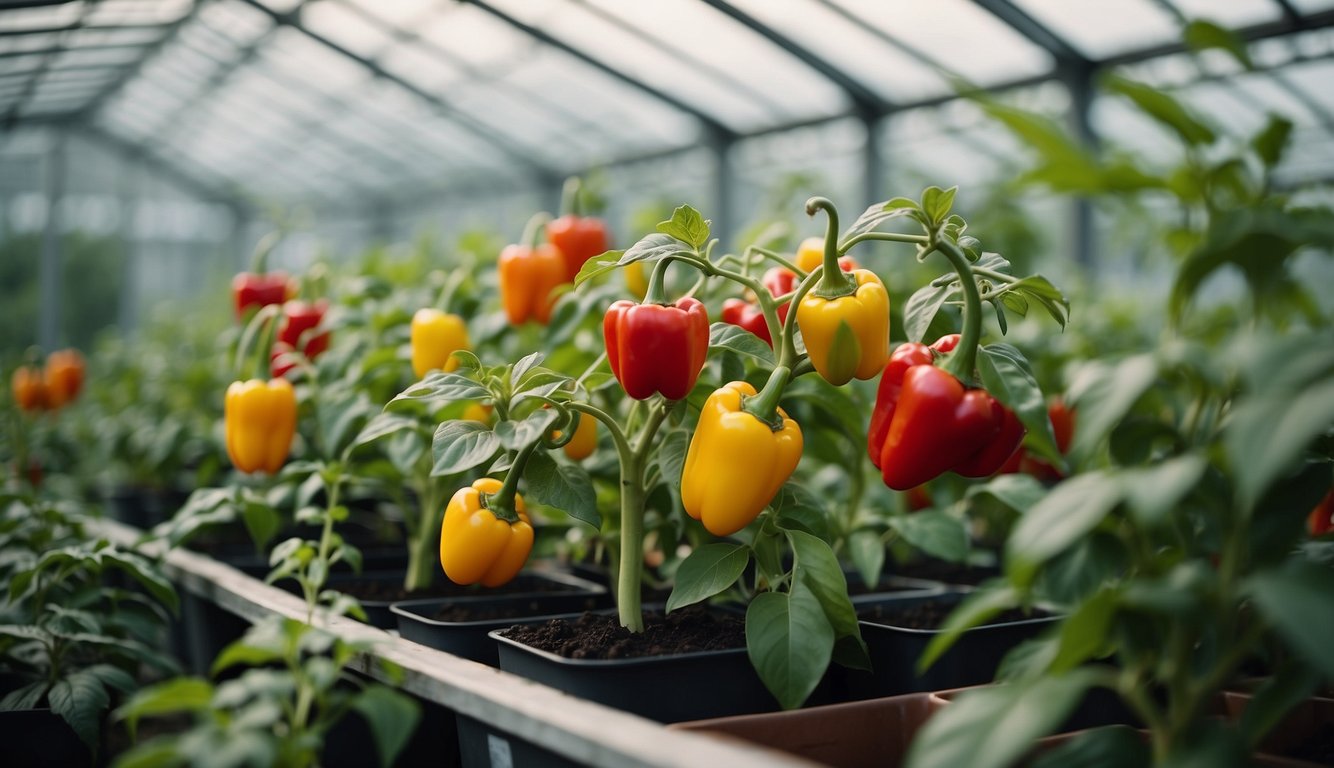
Growing peppers in a greenhouse requires the right potting mix and containers. Choosing the right containers is essential for the proper growth and development of your pepper plants. Here are some things to consider when selecting the right containers for your greenhouse:
Choosing the Right Containers – Growing Peppers in a Greenhouse
When choosing containers for your greenhouse, consider the size, material, and drainage. The size of the container should be large enough to accommodate the root system of your pepper plants. The material of the container can be plastic, clay, or ceramic. However, plastic containers are the most durable and lightweight. The container should also have drainage holes to prevent waterlogging and root rot.
Potting Mix and Repotting
The potting mix is also an important factor to consider when growing peppers in a greenhouse. A good potting mix should be well-draining and nutrient-rich. You can create your potting mix by combining peat moss, vermiculite, perlite, and compost. Repotting your pepper plants is also essential for their growth and development. Repotting should be done when the roots of the plant have outgrown the container. You can repot your pepper plants by gently removing them from the old container and placing them in a new one with fresh potting mix.
In summary, choosing the right containers and potting mix is essential for growing peppers in a greenhouse. The right containers should be large enough, made of durable material, and have proper drainage. The potting mix should be well-draining and nutrient-rich. Repotting your pepper plants when necessary will also help ensure their proper growth and development.
Managing Pests and Diseases – Growing Peppers in a Greenhouse
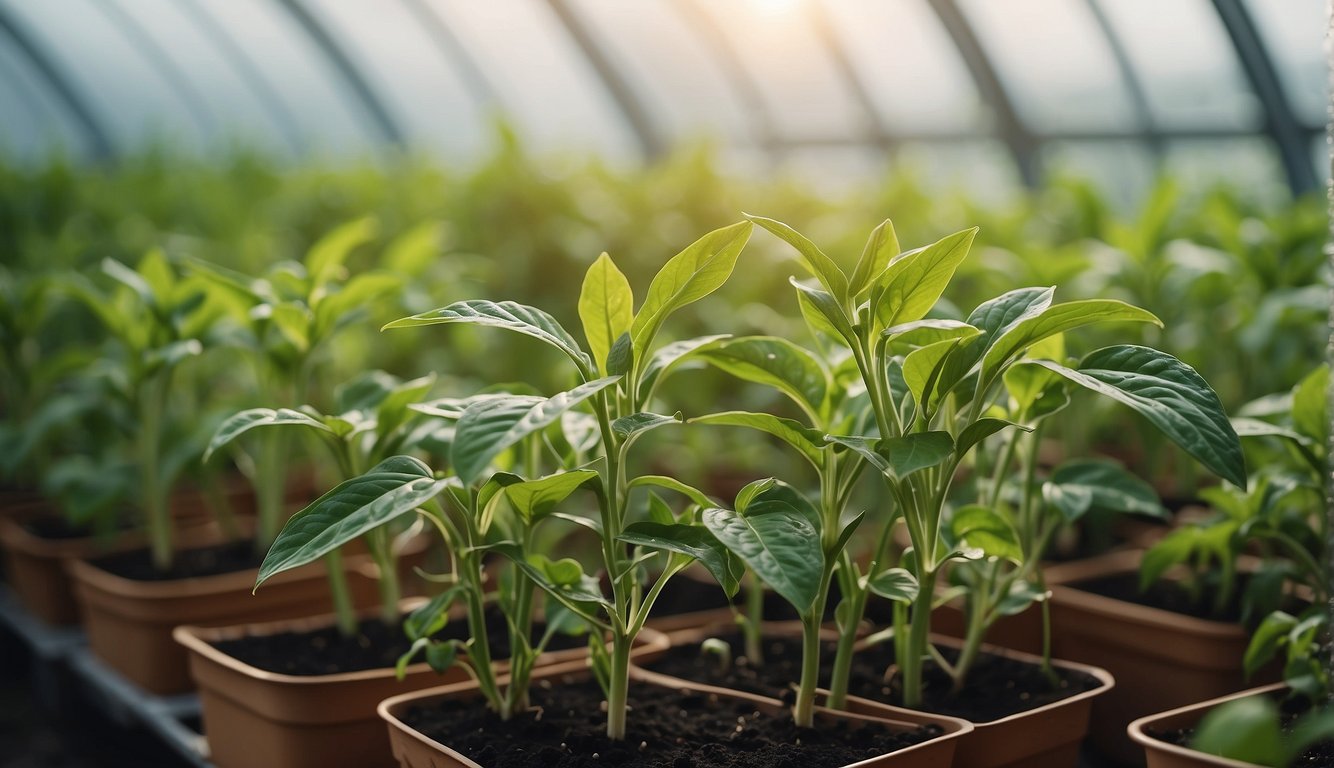
As a greenhouse pepper grower, managing pests and diseases is crucial to ensure optimal yield. In this section, I will discuss common pests in greenhouse pepper cultivation and disease prevention and control.
Common Pests in Greenhouse Pepper Cultivation – Growing Peppers in a Greenhouse
Greenhouse pepper cultivation is susceptible to various pests, including aphids, snails, slugs, flea beetles, and more. These pests can cause significant damage to the crop, leading to reduced yield and quality.
One of the most common pests in greenhouse pepper cultivation is aphids. These small, pear-shaped insects can quickly reproduce and cause damage by sucking sap from the plant. To prevent an infestation, I regularly inspect my plants and use beneficial insects such as ladybugs or lacewings to control aphids.
Another common pest is flea beetles, which cause damage by feeding on the leaves of the plant. To prevent flea beetle damage, I use row covers or insecticides. It’s essential to regularly monitor for pests to prevent an infestation from getting out of control.
Disease Prevention and Control
Diseases can also cause significant damage to greenhouse pepper crops, leading to reduced yield and quality. To prevent disease, I take several measures, including crop rotation, proper ventilation, and sanitation.
One of the most common diseases in greenhouse pepper cultivation is fungal diseases. To prevent fungal diseases, I maintain optimal temperature and humidity levels, as well as adequate ventilation and proper air circulation. I also avoid overwatering and ensure that the soil is well-draining.
Another common disease is bacterial spot, which causes water-soaked spots on leaves and fruit. To prevent bacterial spot, I use disease-resistant varieties and avoid overhead watering. I also practice good sanitation by removing infected plant debris and disinfecting tools and equipment.
Managing pests and diseases is crucial to ensure optimal yield in greenhouse pepper cultivation. By regularly monitoring for pests, using beneficial insects, and practicing disease prevention and control measures, I can maintain a healthy and productive crop.
Pruning and Training – Growing Peppers in a Greenhouse

As a greenhouse gardener, pruning and training are essential techniques to maximize the yield of your pepper plants. Proper pruning can help to increase the number of fruit-bearing branches and promote healthy growth. In this section, I will discuss the different pruning techniques and supporting plant structures that you can use to grow healthy and productive pepper plants.
Pruning Techniques
When it comes to pruning pepper plants, there are two main techniques: topping and pinching. Topping involves cutting off the top of the plant to encourage the growth of side branches. This technique is best used when the plant is young and has only a few branches. Pinching, on the other hand, involves removing the tips of the branches to promote the growth of lateral branches. This technique is best used when the plant already has several branches.
To prune your pepper plants, you will need a good pair of scissors or pruning shears. When pruning, make sure to cut the stem just above a leaf node. This will encourage the growth of new branches and prevent the plant from becoming too tall and spindly.
Supporting Plant Structure – Growing Peppers in a Greenhouse
Pepper plants can become quite tall and heavy, so it is important to provide them with a sturdy support structure. A trellis or stake system is a great way to support your plants and keep them upright. When using a trellis system, make sure to tie the branches to the trellis using soft ties or twine. This will prevent the branches from breaking and allow the plant to grow in a controlled manner.
Another option is to use a tomato cage to support your pepper plants. This is a great option for smaller plants that don’t require as much support. Simply place the cage around the plant and tie the branches to the cage as they grow.
In addition to providing support, a good plant structure can also help to increase the amount of light that reaches your plants. By training your plants to grow in a specific direction, you can ensure that each branch receives an equal amount of light. This will help to promote healthy growth and increase your yield.
Pruning and training are essential techniques for growing healthy and productive pepper plants in a greenhouse. By using the proper pruning techniques and supporting plant structures, you can ensure that your plants grow strong and healthy, and produce a bountiful harvest.
Harvesting and Post-Harvest
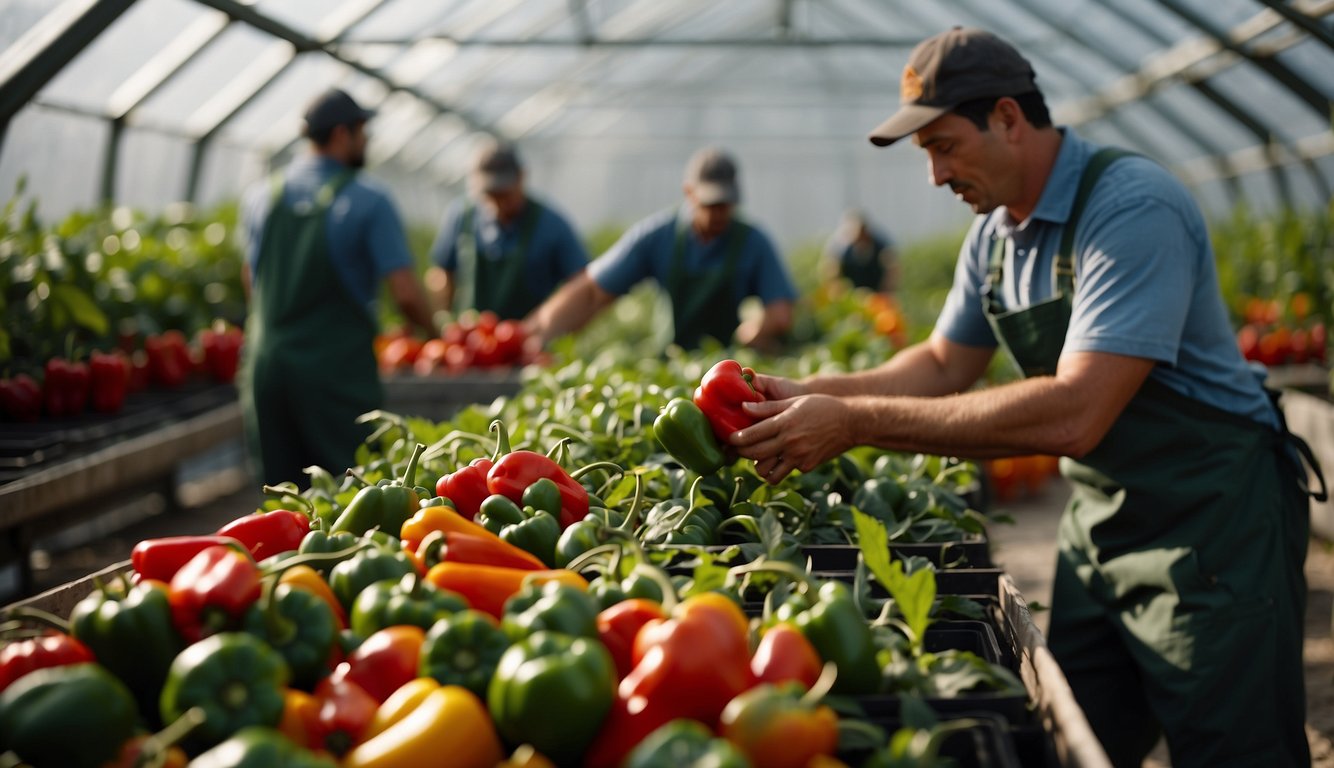
Determining Ripeness – Growing Peppers in a Greenhouse
Determining the right time to harvest your peppers is crucial to ensure optimal flavor and yield. As peppers mature, they change color and develop a sweeter taste. The ripeness of the pepper depends on the variety, so it’s important to know the specific characteristics of the pepper you’re growing.
Generally, peppers are ready to harvest when they reach their full size and have turned their final color. For example, bell peppers are ready when they turn from green to yellow, orange, or red. Hot peppers, on the other hand, can be harvested when they are green or when they have turned their final color.
To determine if your peppers are ripe, gently squeeze the fruit. If it feels firm and the skin is glossy, it’s likely ready to harvest. If the pepper feels soft or wrinkled, it may be overripe or starting to rot.
Harvesting Methods
Harvesting peppers can be done by hand or with the use of tools. For small-scale operations, handpicking is the most common method. Simply grasp the pepper and twist it off the stem. Be careful not to damage the plant or leave any stems on the fruit.
For larger operations, mechanical harvesters can be used. These machines use a series of rotating blades to cut the fruit from the stem. While this method is faster, it can damage the plant and result in lower-quality fruit.
After harvesting, it’s important to handle the peppers carefully to prevent damage. Bruised or damaged peppers are more susceptible to rot and will not store well. Store your peppers in a cool, dry place with good ventilation to prevent mold growth.
Knowing when and how to harvest your peppers is essential to ensure the best quality and yield. Pay close attention to the ripeness of your fruit and handle them with care to prevent damage and spoilage.
Crop Rotation and Companion Planting – Growing Peppers in a Greenhouse
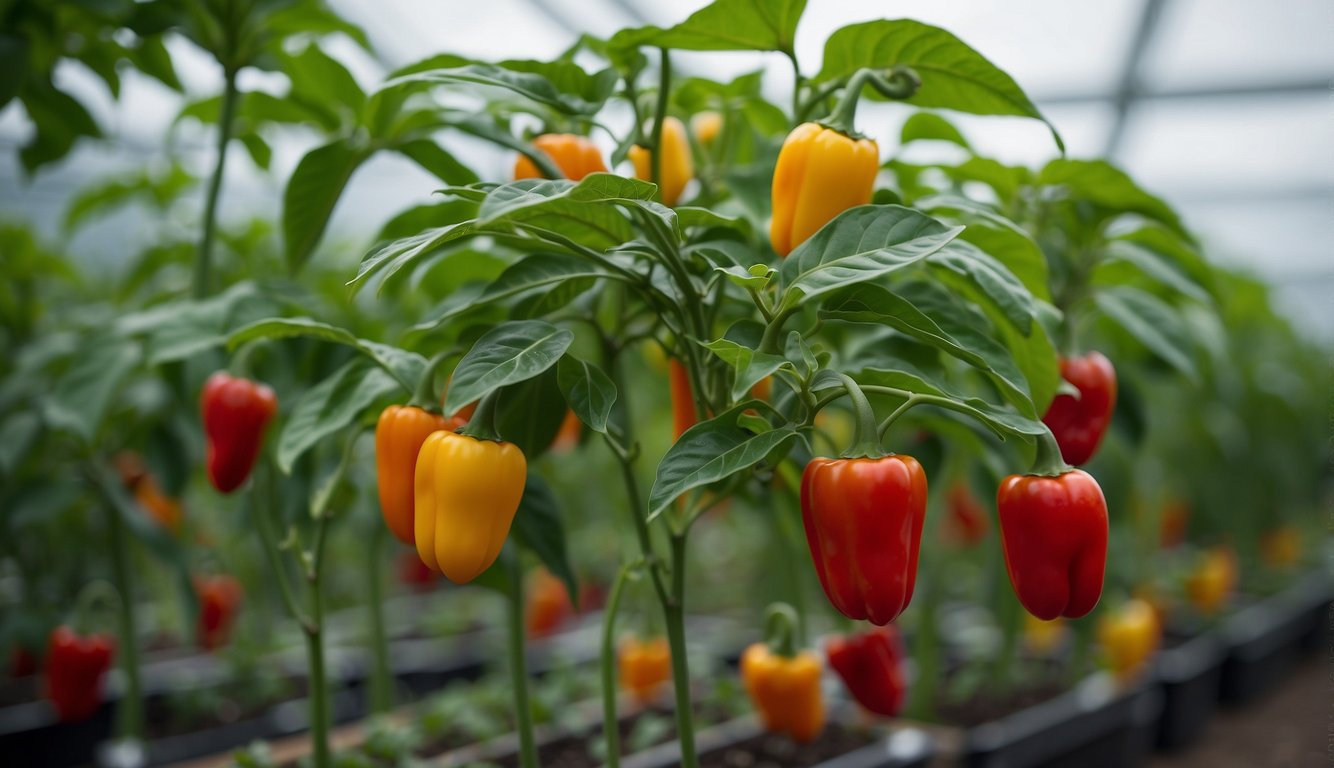
Benefits of Crop Rotation
As a greenhouse gardener, I know that crop rotation is an essential practice to maintain soil health and prevent the buildup of pests and diseases. By rotating crops, I can prevent the depletion of soil nutrients and reduce the risk of soil-borne diseases. For instance, peppers are heavy feeders, which means they require a lot of nutrients to grow. Therefore, rotating peppers with other crops that have different nutrient requirements can help to maintain soil fertility.
Tomatoes are one of the best companion plants for peppers. They are both warm-season crops that require similar growing conditions. When grown together, tomatoes can provide shade and shelter for peppers, while peppers can help to repel pests that attack tomatoes. However, it is important to rotate these crops to prevent the buildup of soil-borne diseases.
Companion Plants for Peppers – Growing Peppers in a Greenhouse
Companion planting is another technique that I use to improve the health and productivity of my pepper plants. Companion plants can help to attract beneficial insects and repel pests, improve soil fertility, and provide shade and support for peppers. Here are some of the best companion plants for peppers:
- Cilantro: Cilantro is an excellent companion plant for peppers. It attracts beneficial insects while also repelling pests like spider mites and aphids. Cilantro and other herbs like dill, oregano, and marjoram grow close to the ground so they won’t compete with peppers for space.
- Tomatoes: As mentioned earlier, tomatoes are great companion plants for peppers. They provide shade and shelter for peppers while also repelling pests that attack peppers.
- Basil: Basil is another herb that is a good companion plant for peppers. It repels pests like aphids, spider mites, and thrips, and attracts beneficial insects like bees and butterflies.
- Onions: Onions are also good companion plants for peppers. They repel pests like aphids, thrips, and spider mites, and improve soil fertility.
By using crop rotation and companion planting techniques, I can maintain the health and productivity of my pepper plants. These practices are easy to implement and can help to reduce the need for pesticides and fertilizers.
Using Greenhouse Peppers
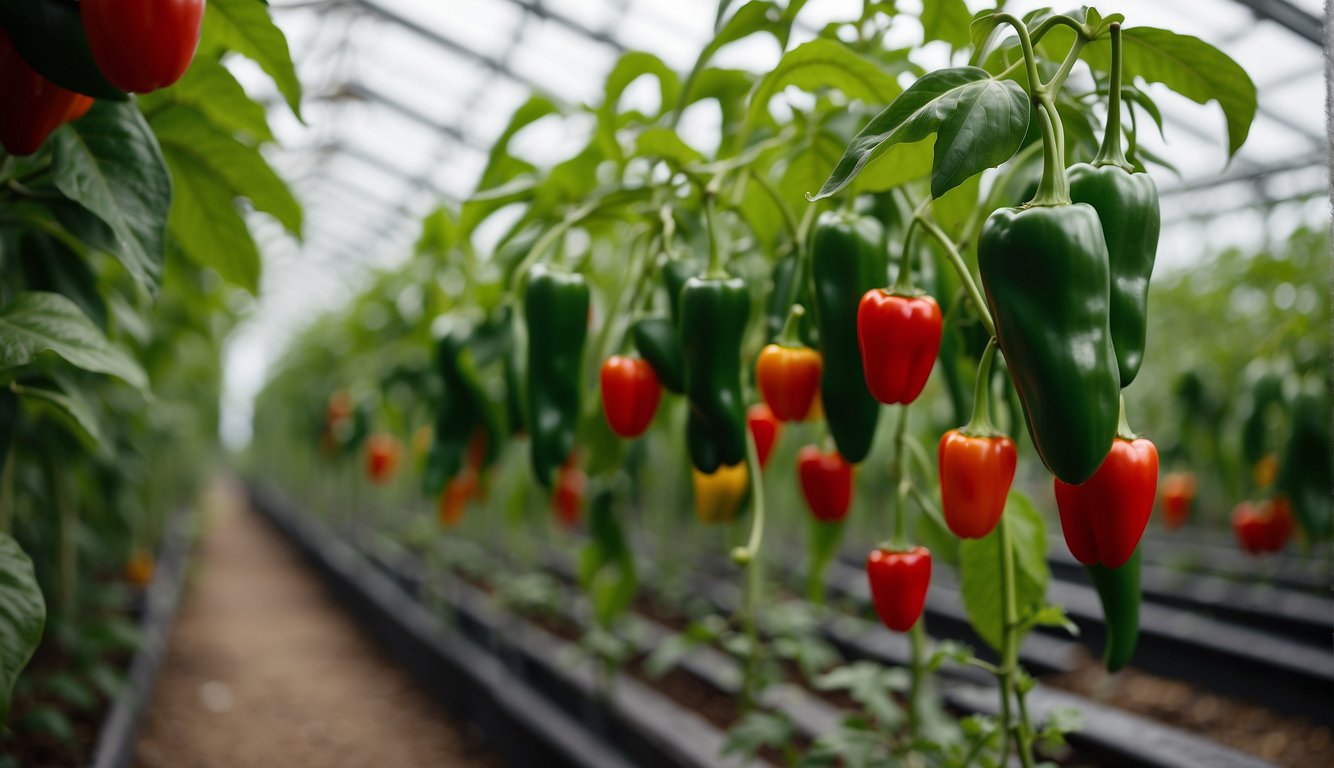
Greenhouse-grown peppers are versatile and can be used in a variety of ways. They are perfect for cooking, adding flavor to dishes, and can be eaten raw in salads. Here are some ways to use greenhouse peppers:
Cooking and Preparation
Greenhouse peppers are great for cooking. They can be used in a variety of dishes, such as stir-fries, stews, and soups. They add a sweet, tangy flavor to dishes, and can be used in both vegetarian and non-vegetarian recipes.
One popular dish that uses peppers is fajitas. Simply sauté sliced peppers with onions and meat or tofu, and serve with tortillas, salsa, and guacamole. Peppers can also be stuffed with rice, meat, or cheese, and baked in the oven.
Fresh Consumption and Salads – Growing Peppers in a Greenhouse
Greenhouse peppers are delicious when eaten raw. They are crunchy and sweet, and can add a pop of color to salads. They can be sliced or diced and added to green salads, pasta salads, or potato salads.
One simple salad that uses peppers is a Greek salad. Simply combine sliced peppers with chopped tomatoes, cucumbers, red onions, and feta cheese, and dress with olive oil and lemon juice.
Overall, greenhouse peppers are a delicious fruit that can be used in a variety of ways. Whether you are cooking with them or eating them raw in salads, they are a great addition to any meal.
Greenhouse Gardening Tips
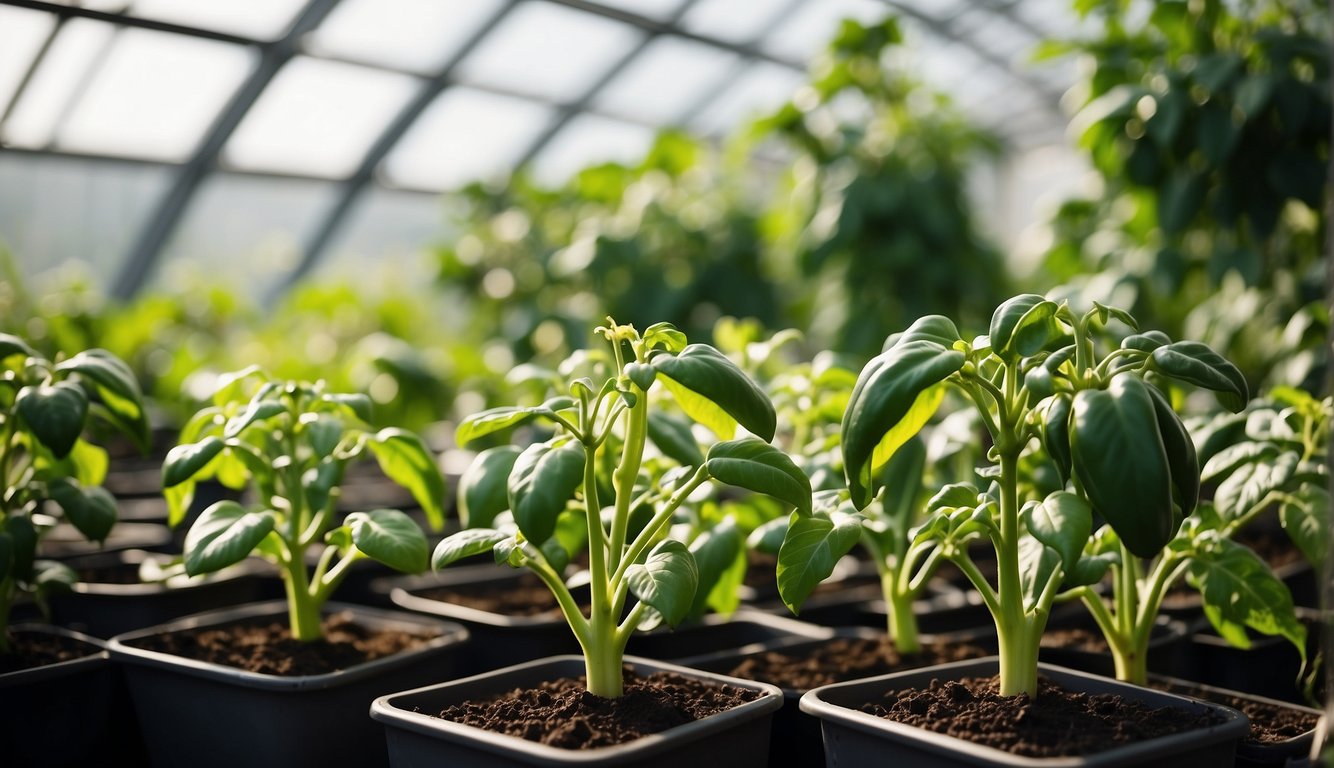
Maximizing Space and Efficiency – Growing Peppers in a Greenhouse
When it comes to growing peppers in a greenhouse, space and efficiency are key factors to consider. To maximize space, I recommend using vertical growing techniques such as trellising or staking. This will not only save space but also provide better air circulation and light penetration.
Another way to maximize efficiency is by companion planting. Peppers grow well with plants such as tomatoes, onions, and basil. By planting these together, you can save space and also benefit from the natural pest control and nutrient exchange that occurs between these plants.
Maintaining Optimal Growing Conditions
Maintaining optimal growing conditions is crucial for the success of your pepper plants in a greenhouse. Temperature and humidity are two important factors to keep in mind. Peppers prefer a temperature range of 70-80°F during the day and 60-70°F at night. Humidity should be kept at around 50-70% to prevent issues such as mold and mildew.
In addition to temperature and humidity, lighting is also important. Peppers require at least 6 hours of full sun per day. If natural light is not sufficient, you can supplement with artificial lighting such as LED grow lights.
To ensure proper watering, I recommend using a drip irrigation system. This will help prevent overwatering and also save time and effort. Lastly, be sure to regularly monitor your plants for pests and diseases and take appropriate action if necessary.
By following these tips, you can successfully grow peppers in your greenhouse and enjoy a bountiful harvest.
The Spicy Connection: Growing Peppers in a Greenhouse and The Herb Prof
Let’s turn up the heat with growing peppers in a greenhouse and its connection to our herbal paradise, theherbprof.com. Ready for a spicy adventure?
Firstly, growing peppers in a greenhouse is a task of precision and care. It’s about providing the right environment for our pepper pals. Sounds familiar? That’s because theherbprof.com helps you create the right environment for your herbal knowledge!
Secondly, both greenhouse peppers and theherbprof.com are about sustainable growth. Just like a greenhouse provides a sustainable environment for peppers, theherbprof.com promotes sustainable practices in herb cultivation. You can check our homepage here!
Lastly, they both aim to enrich our lives. Peppers add a kick to our meals, while theherbprof.com adds a kick to our minds with herbal wisdom.
So, there you have it! Growing peppers in a greenhouse and theherbprof.com are a spicy pair indeed. They both symbolize precision, sustainable growth, and enrichment. Now, isn’t that a hot piece of information to share at your next garden party? Keep growing, folks!
References – Growing Peppers in a Greenhouse
Little Herb Encyclopedia, by Jack Ritchason; N.D., Woodland Publishing Incorporated, 1995
The Ultimate Healing System, Course Manual, Copyright 1985, Don Lepore
Planetary Herbology, Michael Tierra, C.A., N.D., Lotus Press, 1988
Handbook of Medicinal Herbs, by James A. Duke, Pub. CRP Second Edition 2007
The Complete Medicinal Herbal, by Penelope Ody, Published by Dorling Kindersley
Check the Following Articles!
Growing Peppers Indoors Year Round
Hydroponic Basil from Grocery Store: How to Grow at Home
Tomato Leaves Turning White: Causes and Solutions
Frequently Asked Questions – Growing Peppers in a Greenhouse
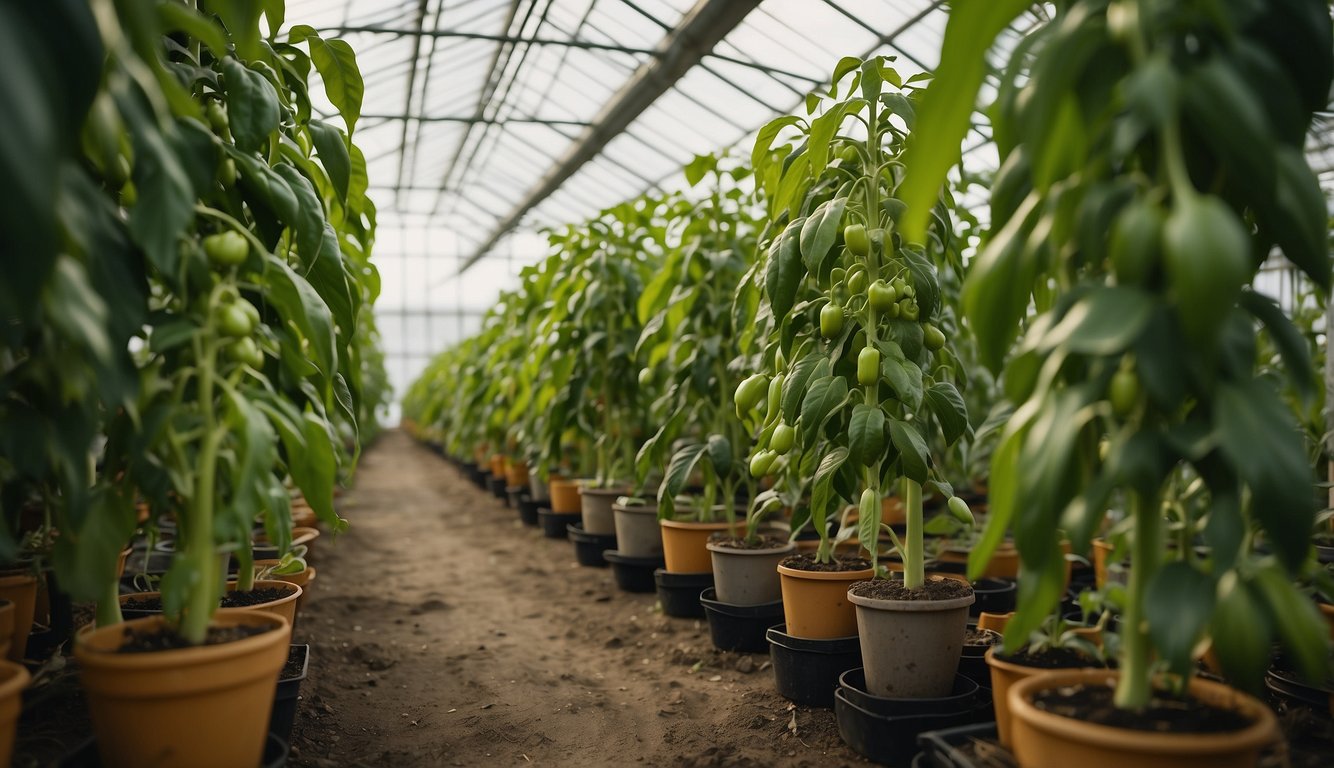
What are the best practices for starting peppers from seed in a greenhouse?
Starting peppers from seed in a greenhouse requires careful attention to temperature, lighting, and humidity. The seeds should be sown in a desired medium 6-8 weeks before transplanting. Maintain a constant 80-90°F (27-32°C) soil temperature. Keep the soil moist, but not too wet. Once the seedlings have sprouted, lower the temperature to 70°F (21°C) during the day and 60°F (16°C) at night. Provide 12-16 hours of light per day.
How can one optimize pepper yield per plant in a greenhouse setting?
To optimize pepper yield per plant in a greenhouse, provide the plants with sufficient light, water, and nutrients. Peppers require full sun (6-8 hours per day) and warm temperatures. Keep the soil consistently moist, but not waterlogged. Use a high-quality potting mix and fertilize regularly with a balanced fertilizer. Prune the plants to remove any dead or damaged branches, and to promote bushier growth.
What are the water requirements for peppers cultivated in a greenhouse?
Peppers grown in a greenhouse require consistent moisture, but not waterlogged soil. Water the plants deeply when the top inch of soil is dry. Avoid getting water on the leaves to prevent fungal growth. Use a well-draining potting mix and add organic matter to improve water retention.
Is it feasible to grow peppers in a greenhouse during winter, and if so, how?
Yes, it is feasible to grow peppers in a greenhouse during winter. However, it requires careful attention to temperature and lighting. Peppers require warm temperatures between 70-80°F (21-27°C) during the day and 60-70°F (16-21°C) at night. Provide supplemental lighting if necessary to ensure the plants receive 12-16 hours of light per day.
What are the advantages and disadvantages of growing peppers in pots versus in the ground within a greenhouse?
Growing peppers in pots allows for greater mobility and flexibility in terms of plant placement. It also allows for easier management of soil quality and moisture levels. However, peppers grown in pots may require more frequent watering and fertilization. Growing peppers in the ground within a greenhouse provides more stability and allows for greater root development. However, it may be more difficult to manage soil quality and moisture levels.
How should one cultivate jalapeños specifically in a greenhouse environment?
Jalapeños can be cultivated in a greenhouse environment using similar methods as other pepper varieties. Provide the plants with full sun, warm temperatures, and consistent moisture. Jalapeños require 70-80°F (21-27°C) during the day and 60-70°F (16-21°C) at night. Fertilize regularly with a balanced fertilizer, and prune the plants to promote bushier growth.
